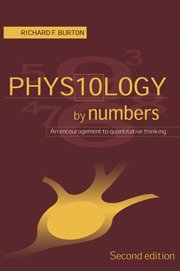Book contents
- Frontmatter
- Contents
- Preface to the second edition
- Preface to the first edition
- How to use this book
- 1 Introduction to physiological calculation: approximation and units
- 2 Quantifying the body: interrelationships amongst ‘representative’ or ‘textbook’ quantities
- 3 Energy and metabolism
- 4 The cardiovascular system
- 5 Respiration
- 6 Renal function
- 7 Body fluids
- 8 Acid–base balance
- 9 Nerve and muscle
- Appendix A Some useful quantities
- Appendix B Exponents and logarithms
- References
- Notes and Answers
- Index
4 - The cardiovascular system
Published online by Cambridge University Press: 06 July 2010
- Frontmatter
- Contents
- Preface to the second edition
- Preface to the first edition
- How to use this book
- 1 Introduction to physiological calculation: approximation and units
- 2 Quantifying the body: interrelationships amongst ‘representative’ or ‘textbook’ quantities
- 3 Energy and metabolism
- 4 The cardiovascular system
- 5 Respiration
- 6 Renal function
- 7 Body fluids
- 8 Acid–base balance
- 9 Nerve and muscle
- Appendix A Some useful quantities
- Appendix B Exponents and logarithms
- References
- Notes and Answers
- Index
Summary
This chapter progresses from blood, through blood vessels, to the heart. Thus, it starts with the erythrocytes (Sections 4.1 and 4.2): circulatory haematocrit, maximum and optimum haematocrits, maximum osmotic swelling of erythrocytes, their lack of nuclei. Moving on to the blood vessels, the chapter considers peripheral resistances (at rest and in exercise, in the systemic circulation and in the lungs) and then some aspects of blood flow and gas exchange in the contexts of blood vessel diameters, body size and exercise. Section 4.5 applies the law of Laplace to arteriolar smooth muscle. The importance of the Frank–Starling mechanism in the matching of right and left cardiac outputs is stressed by means of an obvious calculation that can be generalized to other homeostatic balances. Finally, Section 4.7 looks at the work of the heart. For the renal regulation of blood pressure, see Chapter 6, and, for Purkinje fibres, see Chapter 9.
A well-known relationship that might seem to be under-exploited in this chapter is Poiseuille's equation for the rate of flow of fluid in a cylindrical tube. This is given in Chapter 1 as equation 1.6. Despite its undoubted importance in elementary teaching, the realities of blood flow and resistance are more complicated; flow may be pulsatile or turbulent, viscosities vary with circumstances, the fourth power does not always apply. Thus it is that the full equation does not reappear as such, although components of it do.
- Type
- Chapter
- Information
- Physiology by NumbersAn Encouragement to Quantitative Thinking, pp. 48 - 64Publisher: Cambridge University PressPrint publication year: 2000



